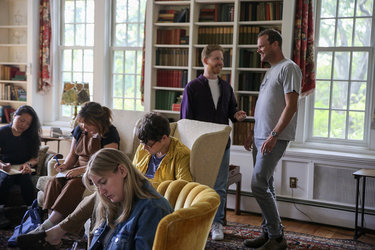Hilltown Commons wins first grant, reinvents itself as a ‘creative campus’
RENSSELAERVILLE — The campus of the Hilltown Commons has a storied century-long history but that very history, embodied in old buildings and sweeping grounds, can also be a liability.
“The path towards sustainability is to be able to generate enough revenue to cover our overhead annually. We are in year one of this,” said Doug Parvis who started as the acting director of the Hilltown Commons in February.
This week, Parvis announced $38,500 in grant funding has been secured through the Empire State Development Strategic Planning and Feasibility Studies Program.
“It’s our first grant under the Hilltown Commons name,” he said, “And we are excited to apply for more grants that can help our campus and help the community.”
The money will be used to develop a master plan to enhance the campus’s historic buildings and make campus improvements, he said.
Parvis envisions a venue that ultimately attracts local Hilltown residents as well as artists, writers, scientists, and others seeking interaction with one another and with the natural world — an antidote to the current “loneliness epidemic,” he says where people focus on screens rather than on one another.
Parvis worked with Jerrine Corallo of Sustainable Growth, a woman-owned grant-writing business, to write the application.
“It’s a large campus with old buildings,” Parvis said, “and we are taking this opportunity to work with an architectural firm and really taking an approach of saying, ‘How can we lower our operating costs so we can spend that money to employ people?’”
This year, Hilltown Commons employed over 40 local people, Parvis said, to do maintenance work on buildings and the grounds and to run the kitchen and serve people who come for retreat workshops.
“You can kind of think of it as a hotel, a restaurant, a conference center, a meeting center, and a community center, all wrapped up into one,” said Parvis. “And we still run it very tightly.”
The 90-acre campus has two large historic homes, a carriage house turned restaurant, a building that houses an auditorium along with office space, three large residences, and several smaller buildings.
The campus is adjacent to the Huyck Preserve, another not-for-profit, which conducts scientific research and offers recreational and educational opportunities.
The past
After World War I, Laura Talmage, an artist and the wife of Frank Huyck Jr., started a series of meetings in Rensselaerville, mindful of preventing another such war. Leaders in economics and education, in history and labor came to the Country Forums on Human Relations.
Pacifist and socialist Norman Thomas was among those attending the country forums and so was Margaret Sanger, the birth-control advocate. The goal was to find ways to peacefully solve problems and resolve differences.
Talmage died in 1958 but her daughter, Katharine, with her husband, Probien Lee Elmore, together with friends Winifred and Everett Clinchy picked up the work in another tumultuous time.
The Elmores had inherited Stonecrop, a sprawling country home, and the Clinchys bought the nearby Edmund Huyck House; they donated their homes and the 90 or so acres of surrounding land to what became the Rensselaerville Institute.
In 1963, it was chartered by the State University of New York and named The Institute of Man and Science, attracting luminaries like United Nations Secretary General U Thant as well as ambassadors to the United Nations and experts on space and science, on history and philosophy. Science fiction writer Isaac Asimov became a regular visitor.
The first world conference to make the environment a major issue, the United Nations Conference on the Environment in Stockholm, held in June 1972, was partly planned in Rensselaerville.
In 1971, technology went on trial as Louis Nizer played the role of judge while those in the mock courtroom investigated the control and direction of technology at the dawn of the computer age.
A conference on nuclear proliferation held at the institute drew Jacques Cousteau and Jimmy Carter.
In 1983, after several strong women objected to the “man” in its name, the organization became The Rensselaerville Institute. In 1926, Katharine Huyck herself had shocked Albany society when she walked unescorted to the altar on her wedding day. According to her Enterprise obituary, she “refused to be handed from the arm of one man to another.”
The institute became known as “the think tank with muddy boots” when, in the 1970s, it switched its focus to learn how self-help could restore a community psychologically as well as physically. The institute, in 1973, bought, for $125,000, a dying company town — Stump Creek, Pennsylvania — with the idea of helping the remaining residents — most were on the verge of abandoning it — to rejuvenate the community.
The institute went on to do the same thing in Corbett, New York, and then, in the 1980s, began a self-help program with the Cherokee town of Bell in Adair County, Oklahoma, and published “The Self-Help Handbook” for community projects. The self-help philosophy was used for government offices and not-for-profits and even for low-performing schools.
Over a decade ago, the campus transitioned again to become the Carey Institute for Global Good. The land was purchased for $1.35 million by William P. Carey, a trustee of the institute for 20 years who had a summer home in Rensselaerville.
Carey, the founder of W. P. Carey & Co., a real estate financing firm, died in 2012 and left the campus to the institute along with an endowment.
Under the leadership of Carol Ash, who had retired as commissioner of the Office of Parks and Recreation in 2010, the institute teamed up with the Logan Foundation, providing support and a safe haven for creators of long-form journalism, and also served as a model farm brewery and incubator for the craft-beer industry.
Ash passed leadership to her son-in-law, Gareth Crawford, who said in 2020, in the midst of the pandemic, that the not-for-profit institute had lost $2 million to $3 million because of the shutdown, unable to carry out its core business of hosting meetings and events.
The campus was listed for sale at $2.75 million but was never sold.
The current assessment roll lists the 90.3-acre campus as having a full-market value of $3,956,129 with a taxable value of zero.
The future
Doug Parvis uses as his North Star a quote frequently attributed to Walt Whitman: “Be curious, not judgmental.”
“That’s also a wink and a nod to the past tradition of this campus from the 1920s, which is global peace talks, the conference center with muddy boots … be curious and not judgmental.”
Parvis grew up in Baltimore, the son of a social worker and healthcare lawyer.
After majoring in finance at James Madison University and graduating from Maryland Law School, he moved to San Francisco where he worked for eight years at Yondr.
“I was employee number two,” he said. “We create phone-free spaces and I still say ‘we’ even though I don’t work there anymore.”
Yondr pouches are being used in many area schools as New York state this school year requires no smart devices be used by students during school hours.
With the grant money he has just secured, Parvis hopes to lower energy costs by making the campus more energy efficient. He said, for example, air leaks can be plugged with insulation.
“That’s a two-fer to me,” he said. “That’s better for the environment; it’s more sustainable and it lowers your operating cost, which means that we have more flexibility — we can hire more people to do the job and grow.”
He also said, “There has just been a lot of deferred maintenance on this campus because for many, many years, even when it was the Rensselaer Institute, it’s high overhead … I have empathy and I’m very humbled by the overhead.”
For the past decade, according to Internal Revenue Service reports, the gap between revenues and expenses has been sizable.
Asked about the deficits in 2020, Crawford said, “It’s the cost of running the company. It’s never been able to pay for itself.”
Part of it has to do with the remote location, Crawford said, and also with the cost of maintaining old buildings. Part of it also has to do with the weather, he said.
“From May to October, people like coming here,” he said, and the institute hosts weddings and conventions. “From the end of October through April, it’s not quite as warm and pleasant.”
At the height of summer, Crawford said in 2020, about 70 people were employed. Some were seasonal or part-time workers; he estimated the institute employed 40 to 50 full-time equivalents year-round.
“We’re really focused on not spending a lot of money,” Parvis said this week.
Parvis doesn’t hesitate to reveal his annual salary of $46,000, far less than his predecessor.
“Basically, no one on this staff is making more than 30 bucks an hour,” he said. “It’s a big switch from the Carey Center.”
The staff consists of four full-time workers — an accountant, the director of operations, the director of programs, and the head of building and grounds — and one part-time worker: a financial advisor.
The Hilltown Commons Board of directors is different from that of the Carey Institute, too, in that all of its members live locally in the Helderberg Hilltowns and the majority are women, Parvis said.
“We’re calling ourselves a creative campus,” he said.
His goal is to regularly fill the campus’s 50 rooms — with a total of 80 beds — by hosting “practical educational workshops.”
Parvis said the community did not like the use of the campus as a wedding venue so weddings are no longer being booked.
This past weekend, 22 people from the Little Nights program were on campus. The program, based in New York City, encourages and teaches people who want to be artists and writers.
Earlier, the Simons Foundation, also based in New York City, used the campus to pair 15 scientists with 15 documentary filmmakers, Parvis said.
One of the aspects that Parvis is most excited about is that, during these weekend retreats, there are often talks that are free and open to the public as there was this past Sunday.
The commons also offers a “commuter rate” for people who pay a lower rate to attend seminars and eat lunch on campus but stay overnight in their own homes.
“We have a lot of momentum, a lot of new energy,” said Parvis. “And now it’s just getting the word out more. Hilltown Commons is still a very new name. So we don’t have too much brand recognition, but we see a path forward with these practical educational workshops that bring people to the campus, allow them to be in nature with one another, to learn something, to better themselves.”
He said the campus’s 180-theater has been “opened up to the community to have town halls, to have talks.”
Parvis cited the recent R’ville Stage Creations’ production of Shakespeare’s “A Midsummer Night’s Dream” as a success. “We did not make money on that one but it was for the community and it brought people to the campus,” he said.
Hilltown Commons also opens its pub on Friday nights and Parvis is delighted that it attracts people from Berne, Knox, and Westerlo as well as Rensselaerville. Additionally, he said, on the last Sunday of every month “a family-friendly brunch” is offered followed by a movie for kids.
“We do a lot of really cool stuff and not too many people attend ….,” he said. “We want a bigger audience.”
Circling back to Laura Talmadge and the origins of the Hilltown Commons, Parvis said, “Like in the ’20s, the global peace talks were a direct result of this horrific war in Europe — and then the subsequent World War II as well. In the year 2025, there’s obviously a lot going on, on a global scale with wars and things of that nature.
“I also think that there are like internal wars going on in our own minds; again, a lot of this is informed by my time at Yondr. But, if we spend our entire lives or the majority of our lives online, and now with AI, it’s a pretty confusing time to be of any generation.
“There is a loneliness epidemic going on for all generations. There are just people who are lonely. They are disconnected from the real world because they are online a lot.”
A central reason to re-open the Rensselaerville campus, Parvis said, was because, after the pandemic, when many people began working remotely and still do, there is a need for human interaction.
“I personally don’t think there’s any substitute for meeting in person and seeing the body language, sharing space and air with people around you. I think people are looking for that,” said Parvis.
He concluded, “Also, many people are not as close to nature or have a relationship with nature. So we kind of have both of that. Like, come to Hilltown Commons if you’re curious. Come if you want to learn a new skill and come because you want to meet people.”


